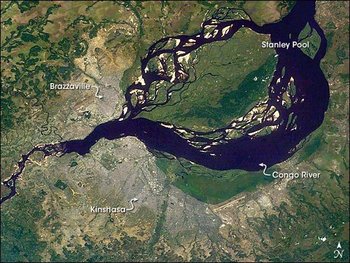Geography of the Republic of the Congo
|
|
Location: Western Africa, bordering the South Atlantic Ocean, between Angola and Gabon
Geographic coordinates: Template:Coor dm
Map references: Africa
Area:
total:
342,000 kmē
land:
341,500 kmē
water:
500 kmē
Area - comparative: slightly smaller than Montana
Land boundaries:
total:
5,504 km
border countries:
Angola 201 km, Cameroon 523 km, Central African Republic 467 km, Democratic Republic of the Congo 2,410 km, Gabon 1,903 km
Congo_republic_sm04.png
Map of the Republic of the Congo
Coastline: 169 km
Maritime claims:
territorial sea:
200 nautical miles (370 km)
Climate: tropical; rainy season (March to June); dry season (June to October); constantly high temperatures and humidity; particularly enervating climate astride the Equator
Terrain: coastal plain, southern basin, central plateau, northern basin
Elevation extremes:
lowest point:
Atlantic Ocean 0 m
highest point:
Mount Berongou 903 m
Natural resources: petroleum, timber, potash, lead, zinc, uranium, copper, phosphates, natural gas, hydropower
Land use:
arable land:
0%
permanent crops:
0%
permanent pastures:
29%
forests and woodland:
62%
other:
9% (1993 est.)
Irrigated land: 10 kmē (1993 est.)
Natural hazards: seasonal flooding
Environment - current issues: air pollution from vehicle emissions; water pollution from the dumping of raw sewage; tap water is not potable; deforestation
Environment - international agreements:
party to:
Biodiversity, Climate Change, Desertification, Endangered Species, Ozone Layer Protection, Tropical Timber 83, Tropical Timber 94, Wetlands
signed, but not ratified:
Law of the Sea
Geography - note: about 70% of the population lives in Brazzaville, Pointe-Noire, or along the railroad between them.
Rivers:
Congo River
Kouilou-Niari River


